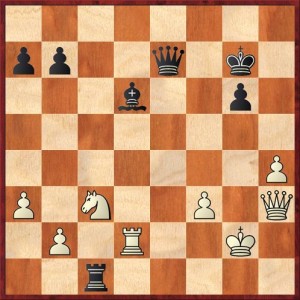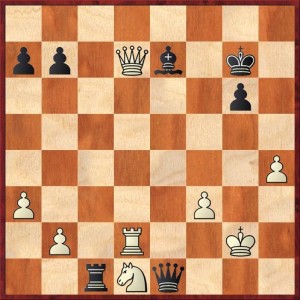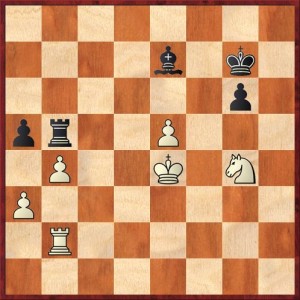Yesterday the Peoples Tournament in Pleasanton ended, with a two-way tie for first place between Ricardo de Guzman (no surprise) and Kesav Viswanadha at 4-1.
Although Kesav was overshadowed in the news last week by two other Bay Area prodigies (Samuel Sevian and Yian Liou, who earned IM norms in southern California) this is a tremendous accomplishment for him in several ways. First, it increases his rating to National Master level, to 2219. He already broke the 2200 barrier once this year and then dropped back down. Perhaps this will be the tournament that gets him over the hurdle for keeps.
Also, this may make Kesav the highest-rated 12-year-old in the country. Here are the top four as shown by the USCF website:
- Jonathan Chiang (TX) 2216
- Tommy He (TX) 2202
- Dachey Lin (TX) 2183
- Kesav Viswanadha (CA) 2169
But those ratings are not current. Looking up these players individually, the up-to-the-minute ratings (including the Peoples Tournament!) are:
- Kesav Viswandaha (CA) 2219
- Jonathan Chiang (TX) 2210
- Tommy He (TX) 2210
- Dachey Lin (TX) 2181
That’s a pretty close race! Of course these are not official ratings yet, so we’ll have to wait for the next supplement before we can proclaim Kesav to be the best 12-year-old.
Kesav clinched his share of first place with a last-round victory over… yours truly. Yes, this time I got to play the role of “NN” who always loses. In truth, it was a very exciting game and I absolutely should not have lost. But still I can’t complain because this is chess. In a time scramble anything can happen, and anything did. More importantly, Kesav won by playing good moves. I don’t want to say anything to downgrade his victory, because he deserved it.
I’d like to show you two critical positions from the game.
FEN: 8/pp2q1k1/3b2p1/8/7P/P1N2P1Q/1P1R2K1/2r5 b – – 0 43
Here Kesav has just played 43. Qc8-h3 and offered me a draw. Now one of the bad habits I have developed in recent years is that I accept draw offers a little bit too readily. In fact, in both of my draws earlier in this tournament it’s arguable that I should have played on. So this time there was no way I was going to accept his offer — especially because I thought I was winning by force!
43. … Qe1!
Of course the bishop cannot be taken because of mate on g1. So White’s next move is forced
44. Qd7+ Be7
I bitterly regret the time I spent analyzing 44. … Kh6? The bishop sac just isn’t sound, because after 45. Qxd6 Qh1+ 46. Kg3 Rg1+ 47. Kf4 White’s king can escape via e3 to the queenside. Fortunately I had a nice safe alternative… but by the time I decided on 44. … Be7 I was down to 7 minutes for the rest of the game. (Kesav had about 15 minutes.)
45. Nd1! (diagram)
FEN: 8/pp1Qb1k1/6p1/8/7P/P4P2/1P1R2K1/2rNq3 b – – 0 45
This move had a huge psychological effect on me. For some reason I just completely overlooked it. Kesav was surprised when I told him this after the game. “It’s the only move!” he said. Well, that’s right. The problem was that I didn’t see White’s only move, and so I thought I was just winning. Now all of a sudden I have to recalibrate my thinking and re-engage in the battle after thinking that I had it won. And I have precious little time left to do it.
Here Black’s move is totally obvious: I should play 45. … Qxh4. Black restores material equality and prevents 46. Qxb7? because of 46. … Qg5+ forking king and rook. Black would still be in the driver’s seat, although I think White can draw after 46. Qd4+.
However, remember that my confidence was wrecked by the fact that I had overlooked White’s last move. I was scared that I might overlook something else. And specifically, I was worried that after 45. … Qxh4 White could play 46. Re2 and win my bishop. As it turns out, it’s not so. After 46. … Qg5+ 47. K any Kf8! defends the bishop and leaves White with no checks. Not only that, the “K any” on White’s 47th move conceals the fact that White’s king actually has no good moves. 47. Kf2 takes the best square away from the knight. 47. Kh2 walks into a mating net. 47. K to first rank self-pins the knight. So in fact, I believe that after 46. Re2? Qg5+ Black is winning.
But I just didn’t have the confidence to play that move, so instead I played the “safer” 45. … Qe5? This keeps control over the e-file, but it allows White to grab a pawn with 46. Qxb7.
Still, we eventually got to an endgame that I should have been able to draw. However, Kesav found a win that surprised not only me but also both tournament directors, who were watching the game closely (because every other game in the tournament had finished long ago).
FEN: 8/4b1k1/6p1/pr2P3/1P2K1N1/P7/1R6/8 w – – 0 57
In the same way that I had been mentally awarding myself a victory after my 43rd move, here I thought the game was as good as drawn. How can White possibly defend his b-pawn?
The answer:
57. Ne3!
That’s how! Now after 57. … ab 58. Nd5! Black must defend or move his bishop, and then 59. ab keeps the pawn plus and is most likely winning because all three of White’s pieces can help the b-pawn move forward. Likewise, none of the sacs, 58. … Rxd5 or 58. … ba, offer any real hope. And now I was down under a minute! Fifty seconds! Forty! Thirty! I’ve got to play something! So finally I desperately played a move that obviously doesn’t work:
57. … Rxe5+
Richard Koepcke said, “You played a tactical trick when you didn’t need to.” But in fact, in view of the above lines, I was busted anyway.
58. Kxe5 Bf6+ 59. Kd5 Bxb2 60. ba
And now it was completely obvious that my bishop cannot stop the a-pawn. If 60. … Bc1 then 61. Nc4 shuts the bishop out. So I resigned, with 22 seconds left on my clock.
To make the defeat even more galling, I realized this morning that I wasted a tempo earlier in the endgame by playing … Bg5-f6-e7. There is a chance that I could have gotten the above position with Black to play, in which case it would indeed have been an effortless draw. Of course it’s impossible to say for sure, because White might have played differently too.
So … a disappointing finish (for me) but a really exciting game, and of course a great triumph for Kesav Viswanadha. He deserved this victory because he kept his poise under great pressure, while I didn’t.






{ 2 comments… read them below or add one }
That Nd1 seems pretty hard to see without the position on the board. It is not only a backward move, but it also relies on the Q, freshly arrived on the d file, to defend d1 together with the R.
I think this is exactly right. Not only that, Black until recently had his bishop on d6, which cut White’s queen off from protecting d1. I think it was a combination of those things, the queen appearing on d7 and the bishop disappearing from d6, that caused me to have a blind spot.